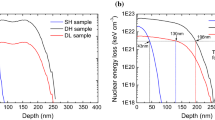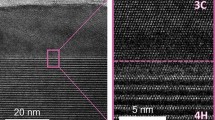Abstract
The cross-sectional morphology of GaAs/Si3N4/SiO2 composite wafer after He+ implantation has been systematically observed. Experiment sample is prepared by focused ion beam system to meet the observation requirements of transmission electron microscope. The results show that implantation of 300 keV, 5 × 1016/cm2 He+ gives rise to formation of bubbles and dislocations in GaAs material, but no cracks are observed. In addition, after annealing, interface separation and micro-gap appear at the interface between GaAs layer and Si3N4 layer. Finally, the mechanisms of bond fracture and blisters formation at the interface are explained by density function theory calculation.









Similar content being viewed by others
References
Kim SH, Geum DM, Park MS et al (2017) Fabrication of high-quality GaAs-based photodetector arrays on Si. Appl Phys Lett 110:0–5
Shim JP, Kim SK, Kim H et al (2018) Double-gated ultra-thin-body GaAs-on-insulator p-FETs on Si. APL Mater 6:016103
Dai P, Yang W, Long J et al (2019) The investigation of wafer-bonded multi-junction solar cell grown by MBE. J Cryst Growth 515:16–20
Kim S, Geum DM, Park MS et al (2015) GaAs solar cell on Si substrate with good ohmic GaAs/Si interface by direct wafer bonding. Sol Energy Mater Sol Cells 141:372–376
Predan F, Hohn O, Lackner D et al (2020) Development and analysis of wafer-bonded four-junction solar cells based on antimonides with 42% efficiency under concentration. IEEE J Photovolt 10:495–501
Yi C, Ma F-J, Mizuno H et al (2020) Application of polydimethylsiloxane surface texturing on III–V//Si tandem achieving more than 2 % absolute efficiency improvement. Opt Express 28:3895
Stanton EJ, Chiles J, Nader N et al (2020) Efficient second harmonic generation in nanophotonic GaAs-on-insulator waveguides. Opt Express 28:9521
Kopperschmidt P, Senz S, Kästner G et al (1998) Materials integration of gallium arsenide and silicon by wafer bonding. Appl Phys Lett 72:3181–3183
Radu I, Szafraniak I, Scholz R et al (2003) Low-temperature layer splitting of (100) GaAs by He+H coimplantation and direct wafer bonding. Appl Phys Lett 82:2413–2415
Yeo CY, Xu DW, Yoon SF, Fitzgerald EA (2013) Low temperature direct wafer bonding of GaAs to Si via plasma activation. Appl Phys Lett 102:054107
Yamajo S, Yoon S, Liang J et al (2019) Hard X-ray photoelectron spectroscopy investigation of annealing effects on buried oxide in GaAs/Si junctions by surface-activated bonding. Appl Surf Sci 473:627–632
Hayashi S, Bruno D, Sandhu R, Goorsky MS (2003) Wafer bonding for III–V on insulator structures. J Electron Mater 32:877–881
Bruel M (1995) Silicon on insulator material technology. Electron Lett 31:1201–1202
Liu C, Wang Z, Li M et al (2008) Effects of the oxide layer on cavity formation and He desorption in He implanted silicon. J Phys D Appl Phys 41:135108
Reboh S, De Mattos AAD, Schaurich F et al (2011) The mechanisms of surface exfoliation in H and He implanted Si crystals. Scr Mater 65:1045–1048
Giguère A, Desrosiers N, Terreault B (2005) Blistering of GaAs by low keV H, D, and He ions. Appl Phys Lett 87:1–3
Shcherbachev K, Bailey MJ (2011) Influence of implantation conditions of He+ ions on the structure of a damaged layer in GaAs(001). Phys Status Solidi Appl Mater Sci 208:2576–2581
Ziegler JF, Biersack JP (1985) The stopping and range of ions in solids. Ion implantation techniques. Springer, Berlin, pp 122–156
Konobeyev AY, Fischer U, Korovin YA, Simakov SP (2017) Evaluation of effective threshold displacement energies and other data required for the calculation of advanced atomic displacement cross-sections. Nucl Energy Technol 3:169–175
Xiao HY, Gao F, Zu XT, Weber WJ (2009) Threshold displacement energy in GaN: Ab initio molecular dynamics study. J Appl Phys 105:123527
Perdew JP, Burke K, Ernzerhof M (1996) Generalized gradient approximation made simple. Phys Rev Lett 77:3865–3868
Christensen A, Carter EA (1998) First-principles study of the surfaces of zirconia. Phys Rev B 58:1–15
Plößl A, Kräuter G (1999) Wafer direct bonding: tailoring adhesion between brittle materials. Mater Sci Eng R Rep 25:1–88
Fuller KNG, Tabor D (1975) The effect of surface roughness on the adhesion of elastic solids. Proc R Soc Lond A Math Phys Sci 345:327–342
Zinkle SJ, Matsukawa Y (2004) Observation and analysis of defect cluster production and interactions with dislocations. J Nucl Mater 329–333:88–96
Fu EG, Misra A, Wang H et al (2010) Interface enabled defects reduction in helium ion irradiated Cu/V nanolayers. J Nucl Mater 407:178–188
Xie H, Gao N, Xu K et al (2017) A new loop-punching mechanism for helium bubble growth in tungsten. Acta Mater 141:10–17
Pizani PS, Lanciotti F, Jasinevicius RG et al (2000) Raman characterization of structural disorder and residual strains in micromachined GaAs. J Appl Phys 87:1280–1283
Taylor A, Boyd RJ (2008) Characterization of the bond between hydrogen and the non-nuclear attractor in anionic water clusters. Phys Chem Chem Phys 10:6814–6819
Wu X, Luo T (2014) The importance of anharmonicity in thermal transport across solid-solid interfaces. J Appl Phys 115:014901
Acknowledgements
This work was financially supported by the National Nature Science Foundation of China (Grant Nos. 61505003, 61674140) and the Beijing education commission project (SQKM201610005008).
Author information
Authors and Affiliations
Corresponding author
Ethics declarations
Conflict of interest
The author has no conflict of interest to declare that are relevant to the content of this article.
Additional information
Publisher's Note
Springer Nature remains neutral with regard to jurisdictional claims in published maps and institutional affiliations.
Rights and permissions
About this article
Cite this article
Huang, R., Li, C., Lan, T. et al. Investigation of interface states between GaAs and Si3N4 after He+ implantation. J Radioanal Nucl Chem 327, 905–911 (2021). https://doi.org/10.1007/s10967-020-07564-0
Received:
Accepted:
Published:
Issue Date:
DOI: https://doi.org/10.1007/s10967-020-07564-0




